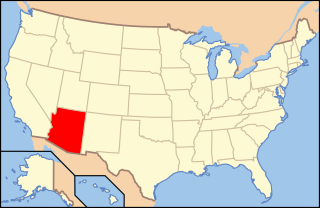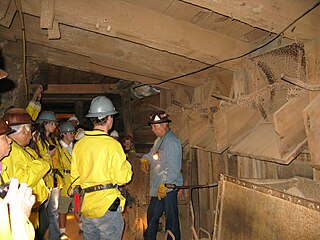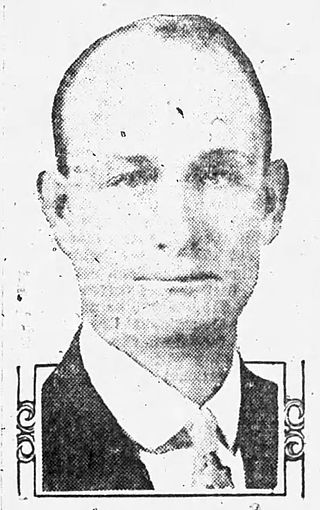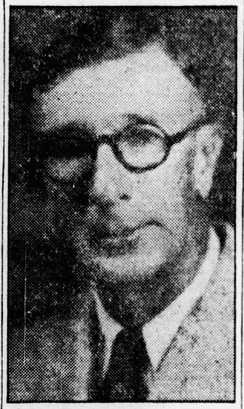Related Research Articles

Phelps Dodge Corporation was an American mining company founded in 1834 as an import-export firm by Anson Greene Phelps and his two sons-in-law William Earle Dodge,Sr. and Daniel James. The latter two ran Phelps,James &Co.,the part of the organization based in Liverpool,England. The import-export firm at first exported United States cotton from the Deep South to England and imported various metals to the US needed for industrialization. With the expansion of the Western frontier in North America,the corporation acquired mines and mining companies,including the Copper Queen Mine in Cochise County,Arizona and the Dawson,New Mexico coal mines. It operated its own mines and acquired railroads to carry its products. By the late 19th century,it was known as a mining company.

James Walter Douglas was a British North America born mining engineer and businessman who introduced a number of metallurgical innovations in copper mining and amassed a fortune through the copper mining industry of Bisbee,Arizona Territory and Sonora before and after the turn of the 20th century.
The 1983 Arizona copper mine strike began as a labour dispute between the Phelps Dodge Corporation and a group of union copper miners and mill workers,led by the United Steelworkers. The subsequent strike lasted nearly three years and resulted in the replacement of most of the striking workers and decertification of the unions. It is regarded as an important event in the history of the United States labor movement.

The Bisbee Deportation was the illegal kidnapping and deportation of about 1,300 striking mine workers,their supporters,and citizen bystanders by 2,000 members of a deputized posse,who arrested them beginning on July 12,1917,in Bisbee,Arizona. The action was orchestrated by Phelps Dodge,the major mining company in the area,which provided lists of workers and others who were to be arrested to the Cochise County sheriff,Harry C. Wheeler. Those arrested were taken to a local baseball park before being loaded onto cattle cars and deported 200 miles (320 km) to Tres Hermanas in New Mexico. The 16-hour journey was through desert without food and with little water. Once unloaded,the deportees,most without money or transportation,were warned against returning to Bisbee. The US government soon brought in members of the US Army to assist with relocating the deportees to Columbus,New Mexico.
Louis S. Cates was an American mining engineer and businessman. He was president of Phelps Dodge from 1930 to 1947.

Louis Davidson Ricketts was an American economic geologist,metallurgist,mining engineer and banker who pioneered development of copper mines in the U.S. state of Arizona and the Mexican state of Sonora.

In Arizona,copper mining has been a major industry since the 19th century. In 2007,Arizona was the leading copper-producing state in the country,producing 750 thousand metric tons of copper,valued at $5.54 billion. Arizona's copper production was 60% of the total for the United States. Copper mining also produces gold and silver as byproducts. Byproduct molybdenum from copper mining makes Arizona the nation's second-largest producer of that metal. Although copper mineralization was found by the earliest Spanish explorers of Arizona,the territory was remote,and copper could seldom be profitably mined and shipped. Early Spanish,Mexican,and American prospectors searched for gold and silver,and ignored copper. It was not until the completion of the Southern Pacific Railroad in 1876 that copper became broadly economic to mine and ship to market.

The Copper Queen Mine was a copper mine in Cochise County,Arizona,United States. Its development led to the growth of the surrounding town of Bisbee in the 1880s. Its orebody ran 23% copper,an extraordinarily high grade. It was acquired by Phelps Dodge in 1885.
The El Paso and Southwestern Railroad began in 1888 as the Arizona and South Eastern Railroad,a short line serving copper mines in southern Arizona. Over the next few decades,it grew into a 1200-mile system that stretched from Tucumcari,New Mexico,southward to El Paso,Texas,and westward to Tucson,Arizona,with several branch lines,including one to Nacozari,Mexico. The railroad was bought by the Southern Pacific Railroad in 1924 and fully merged into its parent company in 1955. The EP&SW was a major link in the transcontinental route of the Golden State Limited.
The Detroit Copper Mining Company was an American copper mining and smelting operation based in Morenci,Arizona. Incorporated in July 1872,it existed as an independent company until 1897,when a controlling interest in the company was purchased by the predecessor of the Phelps Dodge Corporation. It continued to exist as a subsidiary of Phelps Dodge &Co until 1917,when all Phelps Dodge operations in the area were consolidated into the new Phelps Dodge Corporation,Morenci Branch.

The Morenci Mine is a large copper mine located near Morenci,Arizona,United States. Morenci represents one of the largest copper reserves in the United States and in the world,having estimated reserves of 3.2 billion tonnes (3.5×109 short tons) of ore grading 0.16% copper. It is located in Greenlee County,just outside the company town of Morenci and the town of Clifton. Freeport-McMoRan is the principal owner and,since 2016,Sumitomo Group has owned a 28% interest in the mine.

The 1914 Arizona gubernatorial election took place on November 3,1914,for the post of the Governor of Arizona. The Supreme Court of Arizona ruled that there would be no statewide elections in 1912,thus extending the terms to sync up with elections on even years. The Democratic nominee was incumbent governor George W. P. Hunt,his Republican opponent was the final Delegate to Congress from Arizona Territory,Ralph H. Cameron. Cameron was disadvantaged by the same reason the previous Republican nominee Wells was:he had opposed statehood with the present Constitution.

Fred Tuttle Colter was an Arizona rancher and farmer,as well as being the state senator for Apache County beginning with Arizona's second state legislature in 1915. Colter spent six terms in the Arizona Senate. He also led the fight on Arizona's behalf to maintain control over the water from the Colorado River,coining the slogan,"Save the Colorado for Arizona". He was a close ally of the state's first governor,George W. P. Hunt. Prior to his election to the state senate,Colter had served as the state's fair commissioner.

Charles M. Roberts was an American politician who served in the first Arizona State Senate.
George H. Chase (1843-1918) was a politician in Arizona,who served in the first two state legislatures as a state senator.
William D. Whipple was an Arizona politician who served a single term in the Arizona State Senate during the 3rd Arizona State Legislature.
Thomas A. Hughes was an American politician and businessman from Arizona. He served a single term in the Arizona State House of Representatives during the 3rd Arizona State Legislature,and a single term in the Arizona State Senate during the 4th Arizona State Legislature. He owned an insurance agency in Bisbee,Arizona,and later served as an officer of the Hartford Indemnity and Insurance Company.
Celora Martin Stoddard was an American politician from Arizona. He served a single term in the Arizona State Senate during the 5th Arizona State Legislature,holding one of the two seats from Maricopa County. He ran unsuccessfully for the Republican nomination for governor in 1928. A World War I veteran,he helped establish the first American Legion post in Arizona in 1919,and became its first commander. He would later be selected the Legion's state commander,and also served a term as the national vice-commander of the organization. He was well known in the mining industry in Arizona.
Harry W. Hill was an American politician from Arizona. He served four consecutive terms in the Arizona State Senate during the 8th through 11th Arizona State Legislatures,holding the seat from Greenlee County. He served as the president of the Senate during the 9th and 11th legislatures. At the time of his death in 1954,he was one of only two men to have held the president's role three times.

W. B. Kelly,was an American politician from Arizona. He served three terms in the Arizona State Senate during the 10th,11th,and 12th Arizona State Legislatures,holding the seat from Graham County. He was a pioneer newspaper man in Arizona,owning and editing several newspapers,including the Arizona Daily Star,Bisbee Daily Review,and the Graham Guardian.
References
- ↑ "History of the Arizona State Legislature 1912–1966". State of Arizona. p. 82. Retrieved March 3, 2022.
- 1 2 "Harold Elliott Dies After A Heart Attack". Arizona Republic . September 23, 1939. p. 3. Retrieved July 18, 2022– via Newspapers.com.

- ↑ "Comes From Prescott". Bisbee Daily Review . April 9, 1912. p. 8. Retrieved July 18, 2022– via Newspapers.com.

- ↑ "Personal Mention". Bisbee Daily Review . October 12, 1912. p. 2. Retrieved July 18, 2022– via Newspapers.com.

- ↑ "Brief Local Mentions". Bisbee Daily Review . October 30, 1912. p. 8. Retrieved July 18, 2022– via Newspapers.com.

- ↑ "New Smelter Will Help Clifton Much". Bisbee Daily Review . April 4, 1913. p. 5. Retrieved July 18, 2022– via Newspapers.com.

- 1 2 "Tucson Girl Weds Clifton Lawyer". Arizona Daily Star . November 22, 1913. p. 6. Retrieved July 18, 2022– via Newspapers.com.

- ↑ "Engagement Told At Tea". Arizona Republic . May 17, 1936. p. 19. Retrieved July 18, 2022– via Newspapers.com.

- ↑ "For State Senate". The Copper Era and Morenci Leader . July 19, 1918. p. 5. Retrieved July 18, 2022– via Newspapers.com.

- ↑ "Official Primary Results". The Copper Era and Morenci Leader . September 20, 1918. p. 1. Retrieved July 18, 2022– via Newspapers.com.

- ↑ "General Election Returns For Greenlee County, Nov. 5, 18". The Copper Era and Morenci Leader . November 29, 1918. p. 7. Retrieved July 18, 2022– via Newspapers.com.

- ↑ "Official Primary Election Returns". The Copper Era and Morenci Leader . September 17, 1920. p. 1. Retrieved July 18, 2022– via Newspapers.com.

- ↑ "Official Proceedings, Board Of Supervisors, Greenlee County". The Copper Era and Morenci Leader . November 26, 1920. p. 2. Retrieved July 18, 2022– via Newspapers.com.

- ↑ "Back From Phoenix". The Copper Era and Morenci Leader . August 22, 1922. p. 11. Retrieved July 20, 2022– via Newspapers.com.

- ↑ "Phelps Dodge Shows Big Loss For 1921 Year". The Wall Street Journal . April 12, 1922. p. 9. Retrieved July 20, 2022– via Newspapers.com.

- ↑ "For State Senator". The Copper Era and Morenci Leader . June 9, 1922. p. 3. Retrieved July 20, 2022– via Newspapers.com.

- ↑ "Ward Petition Has Most Names Of Any State Candidate". The Copper Era and Morenci Leader . August 18, 1922. p. 8. Retrieved July 20, 2022– via Newspapers.com.

- ↑ "Official Returns Of Election Nov. 7". The Copper Era and Morenci Leader . November 22, 1922. p. 1. Retrieved July 20, 2022– via Newspapers.com.

- ↑ "Stupendous Savings Of Public Monies By State And National Administrations, G. O. P. Record". The Tucson Citizen . September 28, 1922. p. 8. Retrieved July 20, 2022– via Newspapers.com.

- ↑ "Senator Elliott Explains How Finance Code Affects Arizona". The Tucson Citizen . April 20, 1922. p. 8. Retrieved July 20, 2022– via Newspapers.com.

- ↑ "Pure Democracy Vs. Huntism". The Copper Era and Morenci Leader . September 8, 1922. p. 4. Retrieved July 20, 2022– via Newspapers.com.

- ↑ "Arizona Gets Report On Debt: $42,662,110 Outstanding Bonds; State's Share Alone $812,972". Tombstone Weekly Epitaph . December 24, 1922. p. 7. Retrieved July 20, 2022– via Newspapers.com.

- ↑ "Bonded Debt Of 14 Counties And State $42,662,110". Arizona Daily Star . December 17, 1922. p. 1. Retrieved July 20, 2022– via Newspapers.com.

- ↑ "The Financial Code Again". The Arizona Republican . August 17, 1922. p. 4. Retrieved July 20, 2022– via Newspapers.com.

- ↑ "Greenlee Board Gives Result Of County Primary". The Arizona Republican . September 20, 1924. p. 14. Retrieved July 20, 2022– via Newspapers.com.

- ↑ "Session laws, State of Arizona, 1925, Seventh Legislature, Regular Session". State of Arizona. p. ix. Retrieved July 20, 2022.
- ↑ "Elliott Tells Court That Carson's Patents Are Same As Those of Other Inventors". The Tucson Citizen . September 27, 1927. p. 2. Retrieved July 20, 2022– via Newspapers.com.

- ↑ "H. A. Elliott Appointed To River Group". Arizona Republic . November 11, 1933. p. 1. Retrieved July 20, 2022– via Newspapers.com.

- ↑ "Elliott Death Probe Closed". Arizona Republic . September 26, 1939. p. 15. Retrieved July 18, 2022– via Newspapers.com.
